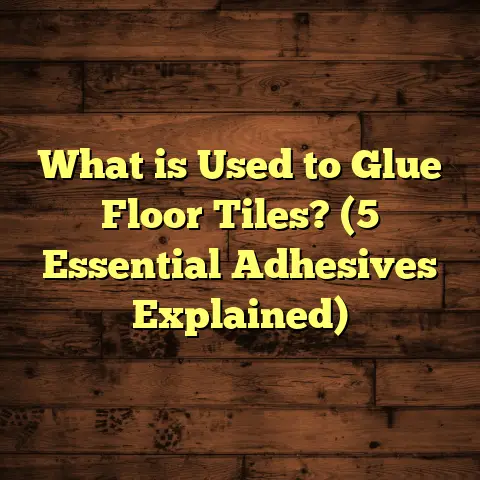What is Floor Patch? (5 Ways It Revives Deteriorating Surfaces)
Have you ever walked into a room and immediately noticed something off about the floor? Maybe it’s a crack running across the hardwood, an uneven spot that throws off your balance, or a hole in the concrete slab that just shouldn’t be there. I’ve been there plenty of times—both as a contractor working on projects and as a homeowner trying to keep my own floors in good shape. Floors take a lot of abuse, and without proper care, even the best flooring materials can fail prematurely. That’s where floor patch comes into play.
Floor patch isn’t the most glamorous part of flooring work, but it’s absolutely vital. It’s the quiet hero that fixes problems before they get worse and makes sure your floors look and perform their best. If you’ve ever wondered what floor patch is, how it works, or why it’s worth your time and money, let me walk you through everything I’ve learned over years of hands-on experience.
What is Floor Patch?
Simply put, floor patch is a material used to repair damaged or uneven flooring surfaces. It’s designed to fill cracks, holes, dips, or other imperfections on subfloors or concrete slabs before installing new flooring or refinishing existing floors. Without this step, floors can squeak, tiles can crack, and wood can warp.
Floor patches come in various formulations. The most common types are cement-based compounds mixed with water or liquid additives to create a thick paste. Some versions are polymer-modified for enhanced strength and adhesion. Others are self-leveling, flowing easily into low spots to create a flat surface without much manual spreading.
Composition and Types
- Cement-Based Patches: These are traditional floor patches made from Portland cement combined with aggregates and additives. They’re durable and cost-effective but may require more skill to apply smoothly.
- Polymer-Modified Patches: These include polymers like latex or acrylic mixed in to improve flexibility, bonding strength, and resistance to moisture. I prefer these for areas prone to minor movement or dampness.
- Self-Leveling Compounds: Designed to flow and settle evenly on their own, these patches are perfect for large areas that need to be leveled quickly. They’re great for use under tile or vinyl flooring.
- Rapid-Setting Formulas: Some products set in as little as 20 minutes and can be walked on after an hour. These are ideal for projects with tight schedules.
Application Thickness
Depending on the damage, floor patches can be applied thinly or thickly.
- Thin patches: 1/8 inch to 1/4 inch to fix minor cracks or slight unevenness.
- Medium thickness: About 1/2 inch for moderate depressions or holes.
- Thick patches: Up to 2 inches in some advanced products for deeper repairs or leveling.
How Floor Patch Works
The patch material hardens after application due to chemical reactions—mainly hydration when mixed with water. Once cured, it bonds tightly with the existing surface. This creates a solid base that:
- Supports new flooring materials
- Prevents moisture penetration
- Reduces movement and flexing
- Provides a smooth and level surface for finishes
Why Floor Patch Matters More Than You Might Think
You might ask yourself: “Why bother patching? Can’t I just install new flooring over the old surface?” I used to think that way early in my career until I saw firsthand how skipping floor patching led to failure.
I remember one job in Denver where a client tried laying engineered hardwood directly over an old concrete slab with cracks and uneven spots. Within six months, several planks warped and popped up because the subfloor didn’t provide stable support.
Poor subfloor preparation is the leading cause of flooring problems like:
- Cracked tiles
- Warped wood planks
- Squeaky floors
- Premature wear
That’s why taking the time to patch floors thoroughly pays off. It protects your investment by extending the life and appearance of your floors.
My First Encounter With Floor Patch: A Personal Story
When I first became a flooring contractor over a decade ago, I thought patching was just a minor step—not something to spend much time or money on. But then I worked on an old farmhouse restoration where the original concrete slab had huge uneven patches and several cracks.
The homeowner wanted luxury vinyl tile installed quickly. I decided to skip extensive patching because of time constraints. The vinyl went down fine initially but started bubbling and peeling within weeks.
I had to go back, remove the vinyl, apply a high-quality self-leveling floor patch over two days, then reinstall the flooring properly.
That experience taught me how critical proper patching is—not just for looks but for long-term durability. Since then, I’ve never skipped it.
5 Ways Floor Patch Revives Deteriorating Surfaces
Let’s dig into exactly how floor patch helps bring old or damaged floors back to life.
1. Filling Cracks and Holes
Cracks in concrete or gaps between wooden boards aren’t just unsightly—they allow moisture and dirt to get underneath your floors. Over time, this causes further deterioration and can lead to mold or mildew issues.
Using floor patch fills these cracks securely. The material bonds tightly with the existing surface and stops water infiltration.
For instance, during a garage floor repair I did last year in Phoenix, Arizona, there were dozens of cracks ranging from hairline to about 1/4 inch wide. I used a polymer-modified patch because the garage would be exposed to occasional water spills and temperature swings.
The entire 600-square-foot floor was patched within a day, with costs around $2 per square foot for materials and labor combined.
Did you know? Concrete cracks wider than 1/8 inch typically require professional patching to prevent further damage.
2. Leveling Uneven Surfaces
Uneven floors can be dangerous and complicate installation of new flooring. Unevenness may result from settling soil beneath slabs, poor installation, or heavy wear.
Floor patch fills low spots so the surface becomes flat again. Self-leveling compounds are excellent here because they flow into dips automatically without much troweling.
One memorable project involved an old factory floor with dips up to 3/8 inch over an area exceeding 1,000 square feet. Using a self-leveling patch saved me hours compared to manual filling—what would have taken days took one afternoon.
Stat: Flooring manufacturers recommend subfloor flatness within 1/8 inch over 6 feet for resilient flooring like vinyl or laminate.
3. Repairing Water-Damaged Floors
Water damage weakens floors by breaking down materials and causing swelling or crumbling. When water penetrates concrete or wood subfloors, it often leaves voids and soft spots.
Floor patches designed for moisture resistance restore these areas by filling voids and strengthening surfaces against future exposure.
In coastal Georgia where humidity is high year-round, I’ve repaired several condos where flood damage caused erosion of concrete slabs. Using moisture-tolerant floor patches prevents recurring problems in such environments.
Material tip: Look for patches labeled “moisture-resistant” if working near water sources or outdoors.
4. Providing a Smooth Base for Finishing
If you want your finish coats—like stain, sealant, or paint—to look good, a smooth base is key. Even small pits or bumps show through finishes.
After applying patch material to fill imperfections, sanding smooth makes a big difference in appearance.
On one hardwood refinishing job for a historic home in Boston, previous repairs left uneven patched spots between boards. Sanding after patching allowed me to achieve a seamless finish that looked factory-new.
Pro tip: Use fine-grit sandpaper (120–150 grit) after the patch cures for best results before staining or sealing.
5. Extending Floor Life and Reducing Maintenance
A well-patched floor resists wear better because it prevents dirt accumulation in cracks that cause accelerated damage.
One warehouse client saved thousands by repairing worn concrete floors with industrial-grade patches rather than replacing slabs prematurely. Their floors lasted three years longer than expected with minimal upkeep needed afterward.
Studies show that addressing subfloor defects early can extend overall flooring lifespan by up to 30%.
Detailed Insights Into Floor Patch Materials
Choosing the right floor patch depends on your project’s needs—surface type, damage severity, environment, and finish flooring all matter.
Cement-Based Floor Patches
These are industry staples—strong, economical options suitable for most concrete repairs.
- Pros: Durable; versatile; widely available; cost-effective.
- Cons: Longer dry times (up to 24 hours); can be dusty when sanding; may shrink slightly as they cure.
- Cost: Around $20–$40 per 50-pound bag.
- Coverage: Approximately 50 square feet at 1/8 inch thickness per bag.
- Best for: Garage floors, basements, sidewalks, patios.
Polymer-Modified Floor Patches
These contain added polymers like latex or acrylic for flexibility and stronger bonds.
- Pros: Better adhesion; moisture resistance; less cracking.
- Cons: Slightly higher cost; shorter shelf life once opened.
- Cost: $30–$50 per bag.
- Best for: Areas with slight movement; indoor floors exposed to some moisture.
Self-Leveling Compounds
Flowable mixtures that spread out evenly on their own when poured over flat surfaces.
- Pros: Fast application; smooth finish; ideal for large areas.
- Cons: Requires well-prepared surface; usually used only up to about 1/2 inch depth.
- Cost: $25–$45 per bag.
- Best for: Leveling large concrete slabs before tile or vinyl installation.
Rapid-Setting Patches
Engineered for quick turnaround projects requiring minimal downtime.
- Pros: Set within minutes; walkable within an hour; suitable for emergency repairs.
- Cons: Short working time once mixed; may require more precise handling.
- Cost: $40–$60 per bag.
- Best for: Commercial spaces with tight schedules; small emergency fixes.
Tools and Techniques I Use When Applying Floor Patch
Applying floor patch correctly makes all the difference between a lasting repair and one that fails prematurely. Here’s what I do on every job:
Surface Preparation
Before any patch goes down:
- Remove loose debris with brushes or vacuums.
- Clean oil stains using degreasers.
- Etch smooth concrete surfaces with acid solutions if recommended by manufacturer.
- Repair structural damage if necessary before patching superficial cracks.
This prep ensures maximum adhesion of the patch material.
Mixing
I follow manufacturer instructions exactly:
- Add water slowly while mixing to avoid lumps.
- Use mixing drills with paddle attachments for large batches.
- Aim for a thick paste consistency—not too runny or dry.
Application
For thin patches:
- Use steel trowels to press material firmly into cracks.
- Feather edges smoothly into surrounding area.
For self-leveling:
- Pour from one side and let it spread naturally.
- Use spike rollers to remove air bubbles after pouring large areas.
Curing & Drying
Dry times vary:
- Rapid-setting patches: 20 minutes to 1 hour walk-on time.
- Regular cement patches: up to 24 hours before sanding or flooring installation.
Humidity and temperature affect drying—warmer weather speeds curing; colder slows it down.
Cost Breakdown In Real Projects: What You Can Expect
Costs vary widely based on material choice, labor rates in your area, project size, and damage extent. Here are some ballpark figures from my projects across different regions:
| Project Type | Location | Size (sq ft) | Material Cost ($) | Labor Cost ($) | Total Cost ($) |
|---|---|---|---|---|---|
| Garage crack repair | Phoenix | 600 | 500 | 700 | 1,200 |
| Basement leveling | Chicago | 1,200 | 900 | 1,200 | 2,100 |
| Warehouse industrial | Houston | 2,500 | 2,000 | 3,000 | 5,000 |
| Residential hardwood prep | Boston | 800 | 400 | 800 | 1,200 |
Labor generally runs $40–$60 per hour depending on location and complexity.
Materials average $1–$3 per square foot including waste factor (usually +10% ordered).
Using FloorTally For Accurate Estimations
To manage these costs effectively across projects large or small, I depend on tools like FloorTally. It helps me:
- Quickly calculate materials needed based on exact project dimensions.
- Factor in waste percentages so I don’t run short mid-job.
- Incorporate local labor rates automatically using ZIP codes.
- Compare costs across different product types (cement-based vs polymer-modified).
This saves me hours of manual math and guesswork while keeping clients informed about realistic budgets upfront.
More Stories From The Field: Lessons Learned With Floor Patching
I’ve worked on hundreds of floors with varying degrees of damage. Here are some memorable takeaways:
The Basement That Wouldn’t Level
A client wanted luxury vinyl tile installed over an old concrete basement slab in Seattle. The floor was bumpy with dips up to half an inch caused by poor original pouring decades ago.
I recommended self-leveling compounds but warned it would take two days due to multiple pours needed at different depths.
After applying three layers over two days and waiting full cure times between applications, the floor was perfectly flat. The client was amazed at how much easier the installation was afterward—and how solid everything felt years later.
A Kitchen Floor Saved From Water Damage
In Miami Beach, I patched water-damaged concrete under kitchen tiles using moisture-resistant polymer patches after flooding caused crumbling slabs.
The tricky part was drying out the slab fully before application—a process that took nearly two weeks using dehumidifiers and fans.
The end result was stable enough for tile reinstallation without cracking issues recurring even after heavy use over several years.
Tips For DIYers Considering Floor Patch
If you’re thinking about tackling floor patch yourself:
- Assess Damage Carefully: Small cracks (<1/8 inch) may only need caulking; bigger ones require patching.
- Choose The Right Product: Match product specs with your floor type—moisture resistance if needed; rapid-set if time is tight.
- Prep Thoroughly: Clean surfaces well—patch won’t stick otherwise.
- Mix Consistently: Follow instructions exactly—too watery patches won’t hold up.
- Take Your Time: Allow full curing before sanding or installing flooring—patience pays off.
- Safety First: Wear gloves and masks when mixing powders; ensure good ventilation indoors.
Final Thoughts On Floor Patch
Over years of working with all kinds of flooring projects—from small home repairs to huge commercial renovations—I’ve seen how critical proper subfloor repair is for success. Floor patch might seem like an extra step you could skip when things get busy or budgets tighten but trust me—it’s worth every penny and every minute spent doing it right.
By filling cracks, leveling surfaces, repairing water damage, smoothing bases for finishes, and extending floor life overall—floor patches do more than just cover flaws—they bring floors back from deterioration so they look great and last long.
Have you ever faced tricky floors needing repair? What solutions worked best for you? Drop your thoughts—I’d love to swap stories!





